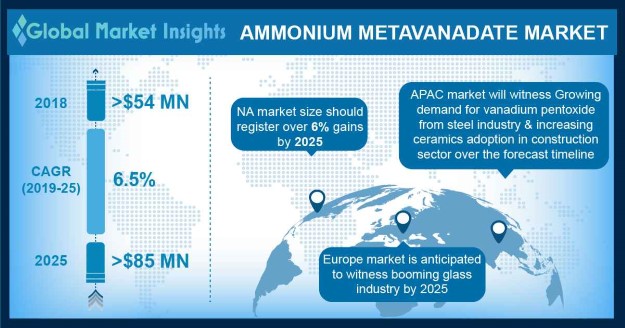Home > Chemicals & Materials > Specialty Chemicals > Custom Synthesis > Ammonium Metavanadate Market
Ammonium Metavanadate Market Size
- Report ID: GMI4402
- Published Date: Oct 2019
- Report Format: PDF
Ammonium Metavanadate Market Size
Ammonium Metavanadate Market size crossed USD 54 million in 2018 and is poised to grow at over 6.5% CAGR from 2019 to 2025.
The product is a white, yellow or clear crystalline powder which is widely used as a laboratory reagent for the production of various chemicals such as catalysts, vanadium pentoxide and polyoxidovanadates. The product releases ammonia gas on heating and finds extensive usage in paints, varnishes, inks, dyes and photographic developers.
| Report Attribute | Details |
|---|---|
| Base Year: | 2018 |
| Ammonium Metavanadate Market Size in 2018: | 54.7 million (USD) |
| Forecast Period: | 2019 to 2025 |
| Forecast Period 2019 to 2025 CAGR: | 6.5% |
| Historical Data for: | 2014 to 2018 |
| No. of Pages: | 155 |
| Tables, Charts & Figures: | 242 |
| Segments covered: | Form, Purity & Applications |
| Growth Drivers: |
|
| Pitfalls & Challenges: |
|
The product contains the heavy metal vanadium with an oxidation state of +5. It is produced by adding ammonium sulfate or chloride to neutral solutions of alkali metal vanadates to stimulate precipitation. It can alternatively be produced by precipitation of vanadium pentoxide alkali solutions with ammonium chloride.
The ammonium metavanadate market finds application in the commercial synthesis of manganese vanadate, silver vanadate and vanadium oxide as it is routinely used as a reagent, intermediate or substrate. It is widely used to produce Mandelin reagent which finds widespread usage in the detection of dangerous drugs such as PMMA, PMA and psychoactive substances. The product imparts a yellow color to the reagent which changes when the reagent is added to a sample containing an alkaloid, thus serving as a useful kit to detect various substances.
The product is ideal as a reagent in the laboratory and analytical chemistry. It serves as a precursor of various medicinal agents on account of its low cost, mild reaction conditions, high yield and operational simplicity. It is used for production of catalysts for inorganic and organic synthesis.
It is among the most common laboratory reagents along with potassium metavanadate used in biotechnology, cell culture, and biotherapeutics. The product plays the role of an intermediate in the synthesis of sodium carbonate and hydrochloric acid. To ensure the steady availability of raw materials for the reaction to continue, the ammonium metavanadate is heated which regenerates the reagents used in the synthesis of sodium carbonate.

